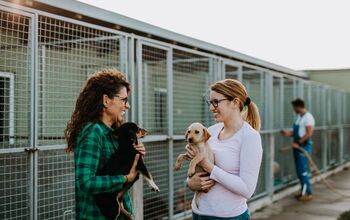What is the Environmental Impact of Owning a Dog?

Most of us think of a negative environmental impact as coming from over-sized vehicles, coal-burning plants, and wasteful use of resources. But did you ever wonder if that mini-might at the end of your leash might also be having an adverse ecological effect on the world?
Neither did I, but the truth is, your dog is a living breathing entity that consumes food, relies on manufactured products for a comfortable life, and ultimately poops wherever he deems appropriate. And while that last one may seem more like messy visual pollution that will eventually break down into the soil, there’s a lot more to it than that.
You see, back in 2017, a researcher at UCLA by the name of Gregory Okin found that pets created the equivalent of 64 million tons of carbon dioxide each year – and that was back in 2017! The catalyst behind his study was the downward trend in the human consumption of meat. While people were eating less animal protein, pets continued to be carnivores and he was curious as to its impact on environmental issues including climate change. You see, in addition to producing close to 5.1 million tons of feces (equivalent to 90 million individuals), Okin found that dogs (and cats) account for 25 to 30 percent of the environmental impact from meat consumption in the U.S.
So, what can you do to help minimize the carbon paw-print your pooch has on the environment? While it may feel like much is out of your control – pets will continue to need meat in their diet, as well as manufactured products – you and your little buddy can still do your part to save the planet. Here are just 5 tips:
- Stooping and scooping are important to not only preserving a pleasant walking environment but for preventing the spread of parasites. But those cheap little plastic bags we buy in volume will typically end up in land-fill. Consider investing in bio-degradable poop bags. The waste can then be tossed into the dedicated “dog-waste” bins located at leash-free parks, or even buried in a compost pile or bin, in your backyard.
- Revisit your pet’s diet when it comes to the manufacturing process. Many brands now offer organic blends and foods that have been sustainably farmed, so you’re able to have a positive impact at the production end.
- Avoid over-feeding your pet or doling out too many of the treats – even the healthy ones. You’ll end up with an obese dog and that means an over-production of poop. Keep him fit and healthy while at the same time reducing the need for extra clean-up bags.
- We know how much our pets love their toys, but we also know they couldn’t care less about prestige and price tags. Check out some of the many squeaky toys made from recycled plastics, organic fabrics, and reclaimed materials that have come out on the market recently. They offer all the same features as the standard brand-names, are built to last (so no need to continually replace), and they arrive with minimal packaging, so less waste.
- Walk when it makes sense. Is it quicker to get to your pet’s favorite leash-free park by car, but is totally walkable if you left a little earlier? Consider your walk to the dog park as part of his daily exercise. Or why not grab the leash and include Rover when you head out on your daily walk or run? It saves a separate drive to the dog park, lets you spend some quality time together, and he’ll be (almost) as happy.

Sharing space with three seriously judgy Schnoodles and a feline who prefers to be left alone. #LivingMyBestLife
More by Mary Simpson























